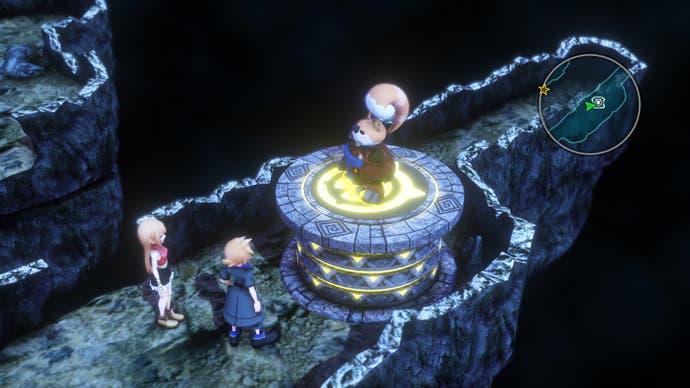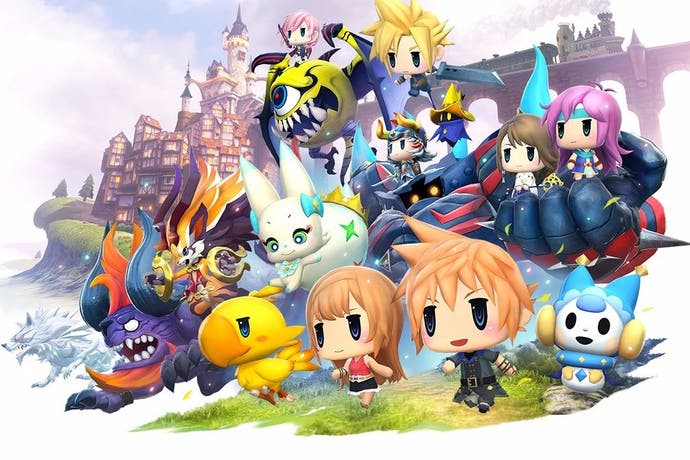World of Final Fantasy review
Aeris lives?
Two amnesiacs, apparently orphaned, on a journey to dethrone tyrants, reconcile kingdoms and suffer the niggling indignity of random battles. World of Final Fantasy, a game that heralds the beginning of a year of 30th Anniversary celebrations for Square Enix's flagship series, trembles with nostalgic resonance. Billed as a return to Final Fantasy's formative style (just as the company readies itself for reactions to the 15th and least conventional game in the series to date), the game revives Koichi Ishii's line-dancing, turn-based battles, as well as the careers of numerous heroes, brought out of retirement for the Disney-esque parade.
As you might expect, it's a game of cutesy nods and winks, a warm soup of fan-service, lumpy with chocobos, moogles, cactuars and all the rest. But for all the predictability, it's also a game that, at its core, answers an entirely unexpected question: would Pokémon be a better game if you could stack the monsters into a weaponised tower?
Lann and Reynn, sibling baristas who work in an abandoned (yet curiously pristine) city, soon discover that they're able to trap the local monsters, known as Mirages, in Prismariums - a kind of snow globe able to miniaturise and hoover up a creature sufficiently weakened to be 'imprismed'. Mirages prove loyal to their captors; once caught they willingly fight to enslave other fauna. World of Final Fantasy's novelty is that a Mirage can be placed on Lann and Reynn's heads, and another, smaller Mirage on top of that. In keeping with Donald Trump's guiding creed, as a tower grows in height so its maker grows in power. Each Mirage's hit points, defensive capabilities and even spells combine when stacked - until, that is, the tower is toppled, at which point its constituent elements scatter to the ground.
The complexity soon piles up. Lann and Reyenn have two forms, which can be switched between at any time. In one, they're dwarfs, drawn in the hyper cute chibi style seen in Square's Theatrhythm series. While in this form, they can ride on a larger Mirage's back, with a smaller Mirage atop the head. In their other 'natural' form, Lann and Reyenn must be placed at the bottom of the stack. At the press of a button you can switch between forms and stacks according to the strengths and weakness of your foe.
Every Mirage you collect, as well as having a huge grid of unlockable abilities, can eventually be 'transfigured' into a larger and more powerful form, allowing it to be placed in a different location in the stack. In this way, you can create stacks of almost any combination, featuring your favoured Final Fantasy monsters, which keep their previously unlocked abilities as they evolve and devolve to suit your needs.
At times, it can seem as though the mechanic got away from its designers a little, as if they began digging at an enticing nugget of an idea, only to uncover a cathedral of potential beneath the surface. This feeling is exacerbated by the relative simplicity of the rest of the game, which series producer Shinji Hashimoto has said in interviews is explicitly designed to appeal to younger players (who will find no delight, presumably, with all the fanfare'd cameos from 90s-era RPGs). The first five chapters of the game are wearingly slow-paced, interrupting the Mirage-capturing with expansive explanations of the simplest concepts. The unfurling intricacy of the battle system and the Mirage-raising possibilities jars with the plainness of the exploration.
Not until much later in the game do the dungeons open up into more alluring warrens, filled not only with secrets, but also puzzles. The exquisite environments excuse the lingering ordinariness, perhaps. The camera glides behind your characters - who are followed or even carried by a Mirage with the suitable ability - along Klonoan set paths, allowing the artists to show off their ice cathedrals, treetop castles and forest thickets from the optimal angles at all times.

Soon enough you'll need to have recruited and unlocked specific Mirage abilities in order to, for example, melt an ice block blocking a pathway, or burn a clump of weeds. Unlike Pokémon, which usually yield once they're sufficiently wounded, certain Mirages only enter the state in which they can be captured after certain conditions are met. You may need to heal a Mirage before it can be imprismed, or inflict a certain status ailment. Other Mirages cannot be imprismed at all as they have another master (usually a familiar antagonist from the series, holed up in some nearby castle). Not until you've defeated their master can that species of Mirage be captured.
World of Final Fantasy relies heavily on the strength of its supporting cast. Lann and Reynn are amiable but uninteresting leads. As amnesiacs, they lack any meaningful motivation beyond a mild interest in their ancestry. The parade of antagonists provide pleasing jolts of recognition when each appears, but this dispersal of threat has a diluting effect on the storyline.
In a manner that has come to define Square's post-Sakaguchi output, the game relies on fan-service in lieu of strong plotting. For the audience, perhaps this will be enough. But despite the pleasing intricacies of its battle system, World of Final Fantasy is unable to transcend the realm of tribute.


